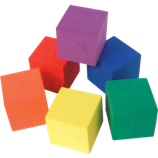State Competition
Competition Specifics
Events using this game format will use the known challenges outlined below, as well as additional unknown challenges that will be released on the day of the contest. Successful teams should pre-build and pre-program their robot prior to the competition for the known challenges. On the contest day, time will be given to account for additional building and programming for the unknown challenges. Expect 1 ½ to 2 hours.
Teams will be allowed shared access to the game tables during this time.
- Divisions
- Junior - Grades 3-8 - Around the Neighborhood
- Senior Grades 9-12 - Autonomous Package Delivery
- Seniors will have additional unknown challenges released on the day of the contest.
- Teams will consist of 2 (two) - 4 (four) youths.
- Each team must be made up of current 4-H members. To sign your team members up for 4-H, contact your local Extension Office and go to 4-H Online
- Competition day for both regional contests: arrive between 9:00 and 9:30, with instructions at 9:45. You will have 2 hours to practice and interview with judges for your Engineering Notebooks.
- Contests will start no later than 12:00
ANNOUNCEMENT!!!
The Indiana 4-H Robotics Competition date will be March 14th, 2026 at the Indiana State Museum!!!!
There will be two regional competitions in 2026 in addition to the State Competition!
Feb. 14th in Bartholomew County, Columbus IN
Feb. 21 in Marshall County, Argos IN
This year, the Junior and Senior competitions are significantly different. Please confirm you are practicing the correct competition.
Junior Game Table Design:
4’X8’ board surrounded by 2X4's The size of the actual board will be 45”x 93”
All assets that do not have a defined starting point on the field will be outside the game board.
While not required, if you would like a game board, it can be purchased at
https://shop.frecklesgraphics.com/purdue_4h_extension_robotics_pl/shop/home
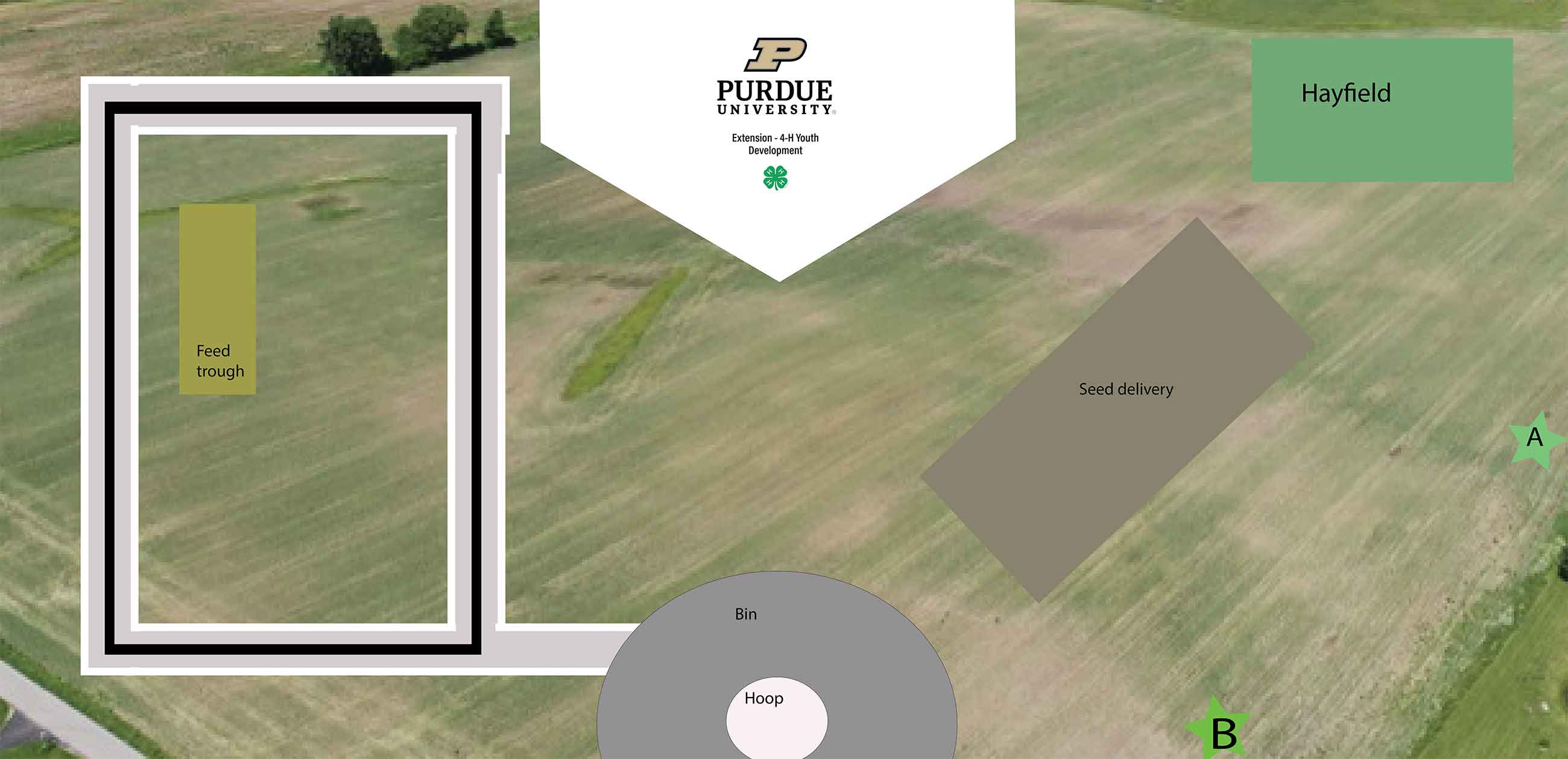
Junior Rules and tasks FOR 2025
|
|
Objective |
Description |
Point Value |
|
1 |
Deliver packages to the houses. There will be 4 houses placed on the outside perimeter of the black road. One foam square in the corresponding color will be delivered to each home.
|
Houses will be 3-D printed and no larger than 12.7 cm sq. (approx. 5 inches)
If a color or light sensor is used for the duration of the trek, bonus points will be awarded. The team captain must notify the judge before starting the challenge that the sensor will be used.
The black line is exactly 6 1/2 inches from the board's edge. |
75 points per package delivered at the matching house. If the wrong color is delivered, the team will earn no more than 25 points. If the package is delivered on the road, the team will lose 15 points. A 100-point bonus for incorporating the color/light sensor
400 points maximum with bonus |
|
2 |
Swing the Baby
|
The swing will be located in the “Hay Delivery” section of the board. Swing will be swung forward and back three times by the robot without the “baby” falling out. |
200 points for successfully completing the challenge.
200 points maximum |
|
3 |
Sandbox Sort – There will be two boxes. One with 3 ping pong balls and 3 boxes, and one empty. All ping pong balls need to be moved to the second box.
|
The green box will contain three ping-pong balls and three foam boxes. The three ping pong balls need to be moved to the orange box. The sandbox will be located near point A, and the empty box near point B |
The score will be tabulated at the end of the match. – 25 points per ball. – 75 points maximum |
|
4 |
See Saw Balance - Balance the two provided foam squares so that the seesaw is balanced and not touching the ground.
|
The seesaw will be located in the Hayfield area and the foam squares will be outside of the field. Foam squares must be touching the last marker on the seesaw to receive points. The board must be approximately balanced and not touching the ground on either side. Points will be awarded at the end of the match
|
50 Points, tabulated at the end of the match |
|
5 |
Terrain obstacle – Each of the 8-10 hex blocks will be fastened to the table with Velcro
|
Up to 10 terrain blocks will be placed between the landing site and the bins. There will be room to move around it, but you will receive a bonus of 150 points if you can navigate over it at least once. all four wheels touch as passing, not necessarily at the same time. |
50 points total While you can navigate the terrain as many times as you’d like, you will only receive points once. |
|
|
|
All known challenges |
675 max points available |
Rules of Play
- At the beginning of the match, your team’s robot must start in the WAITING ROOM. At least one wheel of the robot must be touching inside the WAITING ROOM boundary.
- The GAME ZONE is the area outside of the WAITING ROOM.
- The RESOURCE TRAY is a plastic tray that will be placed on the outside of the game table and will hold game pieces for known and/or unknown challenge(s).
- Robots must be launched from the WAITING ROOM throughout the Before being launched, at least TWO wheels of the robot must be touching inside the WAITING ROOM boundary. The wheel must be attached to the robot at the time of launch and must be within the 13 inch cube of the robot.
- Each match will be 3 minutes.
- Time begins when the announcer says “BEGIN” and continues until the announcer says, “TIME.”
- Any structures built by the team cannot be placed onto the GAME ZONE by human players but are permitted to be placed by the robot so long as it is done autonomously and is permitted by challenge rules.
- No containers used by game officials to store game pieces can be used by the team/robot.
- Players may retrieve their robot at any time during the match without penalty.When retrieved, the robot must return to THE WAITING ROOM. Judges will not assist in retrieval.
- If a player interrupts the robot, the robot must return to THE WAITING ROOM.
- Possession is defined as a piece that is not touching the playing surface and is under the robot's control.
- Items in possession of a robot may be retrieved once any part/piece of the robot has broken the plane of the WAITING ROOM boundary.
- If the robot is in possession of a game piece in the GAME ZONE, and the player retrieves the robot, the game official will return the game piece(s) to its original location/state.
- A player is not allowed to touch any game piece except when the piece is completely inside the WAITING ROOM boundary, OR if the robot is deemed in the WAITING ROOM AND in full possession of a game piece(s). Once the piece is deemed inside The WAITING ROOM, contestants may remove the game piece from the game table/robot and store it in the RESOURCE TRAY.
- If a contestant intentionally touches a game piece in the GAME ZONE, the team will be penalized 50 points per occurrence. Judges will issue one warning for the first offense. In such cases, the piece will be returned to its original starting position by contest officials as quickly as possible.
- All competing team members are allowed around the game table during the competition, and any member may touch the robot if necessary. Once a robot is “touched,” it must be moved back to THE WAITING ROOM
- Teams not competing must remain at their tables or staging
- Good sportsmanship is always crucial during practice times. Practice time on the game table may be restricted as build time progresses.
- Practice time will be approximately 1 ½ - 2 hours between check-in and the start of matches. You will be assigned a match table and will share practice time with other teams.
- At the conclusion of the match, it is the responsibility of the team captain to review the score sheet with the judge and then initial at the bottom, signifying agreement of the final match score. Scores are final after this point and cannot be contested.
Equipment Rules
- Robots must fit in a 13-inch cube at the start of play. They can expand another 5 inches in any direction after being placed on the field, making the robot a maximum of 18 inches long.
- You can have a maximum of one controller active in a match
- You can use any sensors necessary to complete your challenges
- At the start of the match, your equipment may be stored off the table or in the launch area. It may not be in the play area until the timer has started.
Junior Scoring Rules and Rubric
- After 3 minutes, the match will end. Do not touch your robot until scoring is finalized.
- Unless otherwise specified, scoring will take place at the end of the match.
- If a team cannot run their robot, they can still gain points with their engineering notebook.
- The referee will document the results of the match with the team captain. The captain will initial the results, and it will become final at that point.
- Each team will have two attempts per round. Only the high score will be recorded. In the case of a tie, the second score will be used to make the final decision.
|
Game Rubric |
||||
|
|
Objective |
Description |
Point value |
Points Awarded |
|
1 |
Package Delivery - Deliver packages to the houses. There will be 4 houses placed on the outside perimeter of the black road. One foam square in the corresponding color will be delivered to each home |
Houses will be 3-D printed and no larger than 12.7 cm sq. (approx. 5 inches)
If a color or light sensor is used for the duration of the trek, bonus points will be awarded. The team captain must notify the judge before starting the challenge that the sensor will be used.
The black line is exactly 6 1/2 inches from the board's edge. |
75 points per package delivered at the matching house. If the wrong color is delivered, the team will earn no more than 25 points. If package is delivered in the road, team will lose 15 points. A 100-point bonus for incorporating the color/light sensor
300 points maximum |
|
|
2 |
Swing the Baby |
The swing will be located in the “Hay Delivery” section of the board. Swing will be swung forward and back three times by the robot without the “baby” falling out. |
200 points for successfully completing the challenge.
200 points maximum |
|
|
3 |
Sandbox Sort – There will be two boxes. One with 3 ping pong balls and 3 boxes, and one empty. All ping pong balls need to be moved to the second box
|
. The green box will contain three ping-pong balls and three foam boxes. The three ping pong balls need to be moved to the orange box. The sandbox will be located near point A, and the empty box near point B |
The score will be tabulated at the end of the match. – 25 points per ball. – 75 points maximum |
|
|
4 |
See Saw Balance - Balance the two provided foam squares so that the seesaw is balanced and not touching the ground. |
The seesaw will be located in the Hayfield area, and the foam squares will be outside of the field. Foam squares must be touching the last marker on the seesaw to receive points. The board must be approximately balanced and not touching the ground on either side. |
50 points total tabulated at the end of the match. |
|
|
5 |
Terrain Challenge |
Up to 10 terrain blocks will be placed between the landing site and the bins. There will be room to move around it, but you will receive a bonus of 150 points if you can navigate over it at least once. All four wheels touch as passing, not necessarily at the same time. |
50 points total tabulated at the end of the match
|
|
|
|
|
All known challenges |
675 max points available |
|
Senior 4-H Robotics Delivery Challenge: Autonomous Package Delivery
Theme:
Design and program an autonomous robot to deliver packages to the correct houses in a neighborhood while avoiding obstacles and protecting property.
Competition Overview
Participants will design and program fully autonomous robots capable of identifying, collecting, and delivering color-coded packages to matching homes on a 4x8-foot game mat. Robots must complete deliveries while avoiding obstacles such as parked cars, dogs, and fire hydrants.
Robots earn points based on accuracy, placement, and adherence to rules of safety and efficiency.
Eligibility
- Open to youth in grades 9–12.
- Teams may consist of 2–4 members.
- Each team must use a single robot per match.
- Robots must be autonomous (no remote control after start).
Robot Requirements
- Platform: Teams may use LEGO SPIKE Prime, VEX IQ, VEX V5, Arduino, Raspberry Pi, or similar systems capable of full autonomy.
- Size limit: Robot must start within a 13"x13"x13" cube and expand another 5 inches in any direction after being placed on the field, making the robot a maximum of 18 inches long.
- Power: Battery-powered only, no external power or tethers.
- Sensors: Any onboard sensors may be used (color, distance, camera, gyro, etc.).
- No Wi-Fi, Bluetooth, or remote-control during run (except to start the program).
Game Field Description
- Field size: 4 ft x 8 ft mat with printed “neighborhood” layout.
- Elements include:
- Truck zone: Starting area containing all packages for delivery.
- 4–6 houses: Each marked with a distinct color.
- Driveways, yards, sidewalks, and mailboxes for each home.
- Obstacles: Parked cars, dogs, fire hydrants, trees, and curbs.
Note: Layout and obstacle placement will be consistent for all teams during a given round.
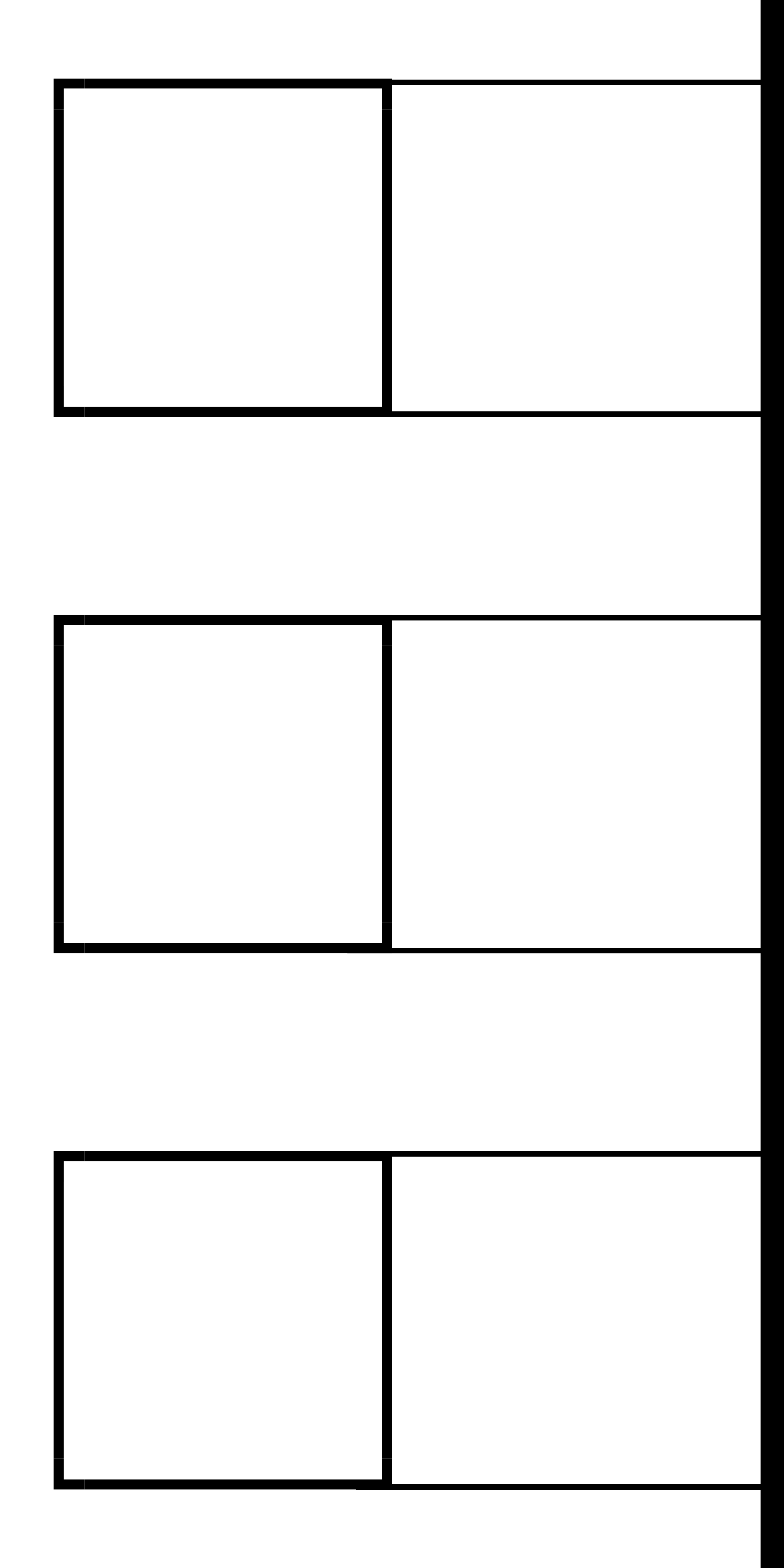

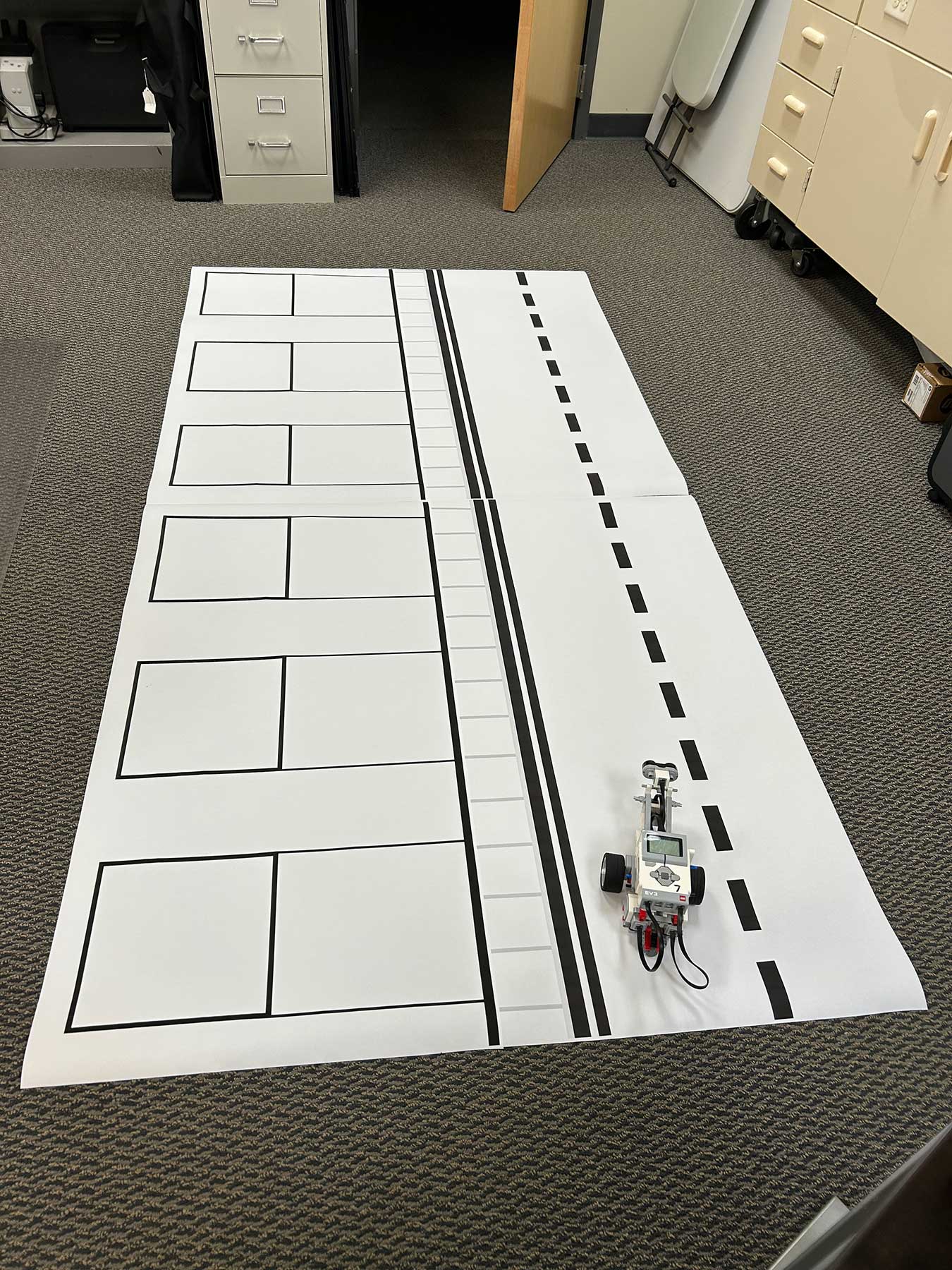
Game Objective
Deliver as many packages as possible to the correct colored homes accurately and safely within the time limit.
Delivery Rules:
- Packages are color-coded to match the target house.
- Packages begin at the truck zone and must be autonomously delivered to the correct home.
- Some houses will have a return package (marked differently) that must be picked up and returned to the truck.
Match Format
- Each team has 2 minutes and 30 seconds to complete as many deliveries as possible.
- Robots must start completely inside the truck zone.
- Teams may touch or reset their robot only by forfeiting a 10-point penalty and returning it to the truck zone.
- Robots must be autonomous from start to finish (only one start button press allowed).
Scoring System
|
Action |
Points |
|
Package delivered on doorstep |
+30 |
|
Package delivered on driveway |
+20 |
|
Package delivered by mailbox |
+15 |
|
Package placed in yard |
+10 |
|
Returned package successfully to truck |
+25 |
|
Avoiding all obstacles (clean run) |
+20 bonus |
|
Minor property contact (bump without damage) |
-5 each |
|
Major property damage (drive over yard, hit obstacle, etc.) |
-10 each |
|
Manual reset/touch |
-10 each |
|
Delivery to wrong house |
-15 |
|
Exceeding time limit (stopped robot manually) |
0 additional points |
Time Efficiency Bonus
If a team finishes all deliveries (either all packages delivered and/or returned) before the 2-minute 30-second limit, they receive bonus points based on the time remaining:
|
Time Remaining |
Bonus Points |
|
0:30 – 0:59 remaining |
+10 points |
|
1:00 – 1:29 remaining |
+20 points |
|
1:30 or more remaining |
+30 points |
Competition Rounds
- Practice Round: 1 official practice run per team.
- Qualifying Rounds: 2 matches; best score counts.
Finals: Top 3–5 teams advance for a single championship match.
Judging & Tie-Breakers
Judges will evaluate based on:
- Highest score achieved
- Fastest time to complete all deliveries (if tied on points)
- Engineering Design Notebook ( – Required – worth 525 points. Rubric on website, including judge interview.
Safety & Conduct
- Robots must not launch, throw, or eject parts or packages.
- Youth participants must do all programming.
- Coaches may assist in setup but not in operation.
- Respect for judges, other teams, and materials is mandatory.
images of senior obstacles, with dimensions in mm and the contest layout.
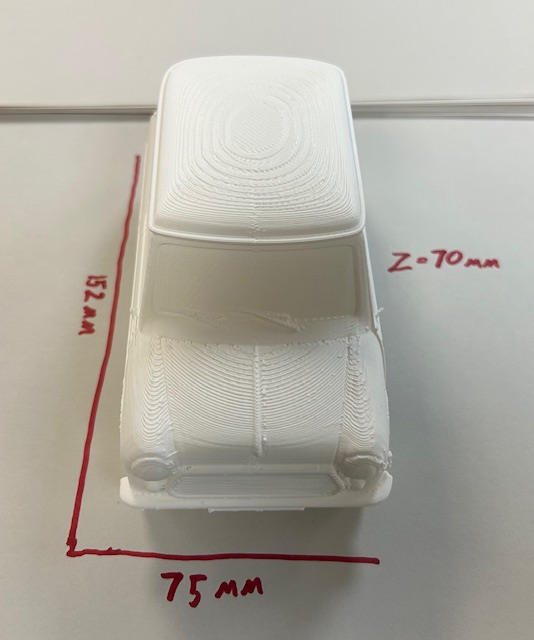
Car in driveway, 75x152 mm
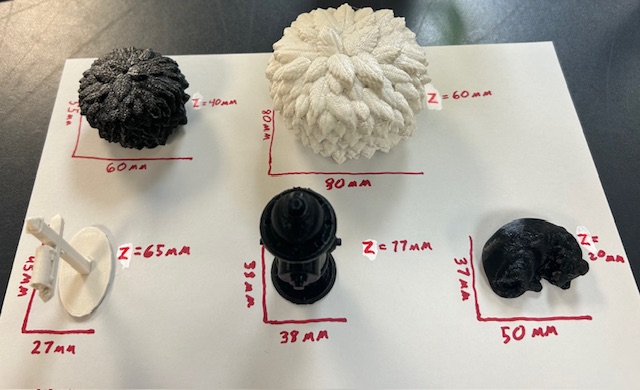
bush a: 55x60x40 mm
bush b: 80x80x60 mm
Mailbox 45x27x65 mm
fire hydrant 38x38x77 mm
sleeping dog 37x50x20 mm
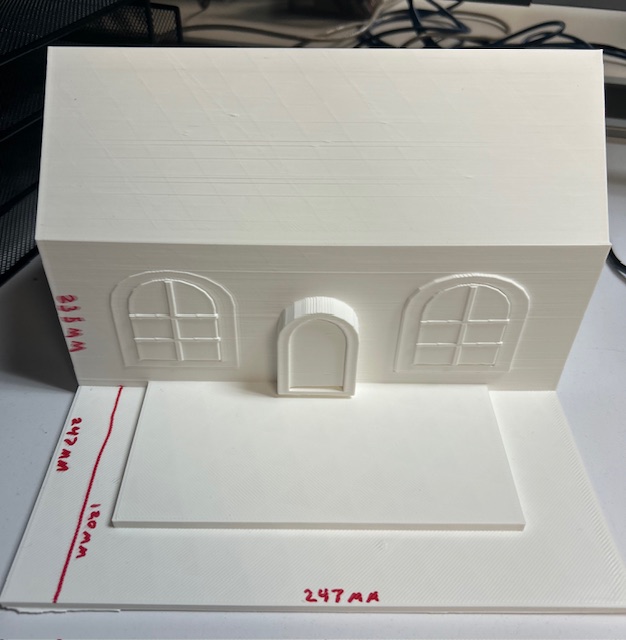
House 247x247x235 mm with 120mm porch
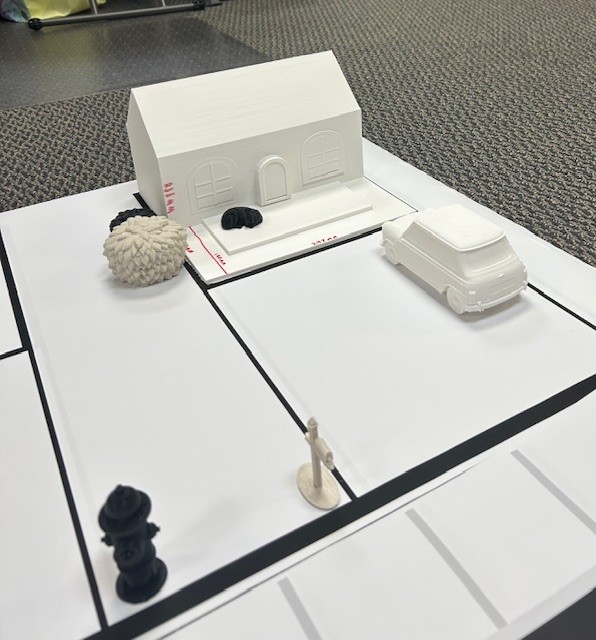
Layout in each space
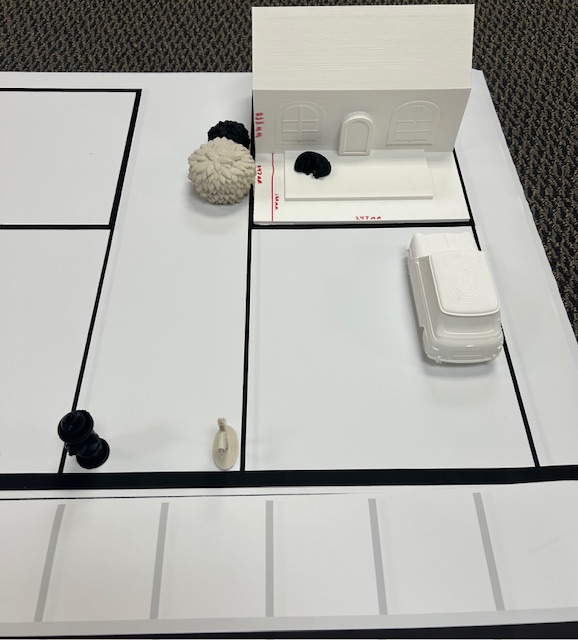
Top/front view of layout
Robotics Engineering Notebook - All Levels
Adapted from the University of Idaho Extension “All about the FTC Engineering Notebook”.
Why an Engineering Notebook?
An engineering notebook is a working document. It is where ideas, sketches, and team thoughts are recorded in addition to the final production information about your team and robot. It is a journal your whole team will use to help everyone know what’s going on, where you record your testing data, and it is a record of your abandoned ideas and prototypes.
- Engineering notebooks show the thought behind your strategy, designs, innovations, and organization. They show how each team member contributes and how your team overcomes obstacles. These things are hard to see at an event when you are there with a finished product.
- Your engineering notebook is the primary reference for your team. It records all thoughts at meetings and events, all ideas for robot design, all changes to the code (although the actual code does not need to be included), and game strategy. A notebook is a tool for the entire team to communicate together. It should be used as a reference for the team and the judges.
- An engineering notebook is a tool to show how your team works, what you do, and the concepts you explore with your sponsors and potential sponsors.
- Judging your notebook will include written content and a short, one-minute presentation to the judges. All members must participate and be able to talk about what is in the notebook.
Should I follow this formatting guideline?
The short answer is yes; some of the guidelines are presented as optional. Still, by closely following the guidelines, you make your engineering notebook easier for the judges to understand and make it eligible for all awards
If you plan to use a handwritten notebook, it is a good idea to divide the sections before you start writing or decide if you want to use multiple small notebooks to document your season. Remember that your meeting discussions are as important as your engineering, game strategy, and programming thoughts when considering the awards. Showing how your team uses all of its strengths to overcome engineering challenges is critical, including all aspects of the team. You also have the option of using an electronic notebook. These can be easier to use if you are meeting in different places; as long as you have access to it, no one will forget to bring the notebook. While the judges do not differentiate between a handwritten notebook and a printed one, there are pros and cons that each team should consider.
|
Handwritten Engineering Notebook |
Electronic Engineering Notebook |
|
Pros: Easy to use – everyone can write on paper • Already printed and bound, what you see is what you have • Easy to show how the whole team contributed with different writing styles, ink, and signatures • Easy to reference during the build season • Shows its use with stains, cross-outs, and worn pages • Easy to add tabs and make ready for competition (the pages your team referenced the most will be the ones the judges want to see.) |
Pros: • Available anywhere (if in the cloud) • Spell checked, and legible • Easy to add images and summaries, and they won’t fall out • No worries about running out of pages in a section and running into the next section • If you forget it at home, it can be reprinted anywhere. • Can print a new copy to mark for each competition. – although not necessarily advised
|
|
Cons: • Each section needs to be decided at the beginning of the season; it’s impossible to change mid-way through. If you don’t have enough pages, you have to use pages in the back or a second notebook. • Not everyone has really legible handwriting or spelling, but everyone does need to contribute. • Must be remembered everywhere you go, especially to tournaments.
|
Cons: • Not easy to tell that everyone has contributed to the notebook. • Need to remember to print and get it in an appropriate binder for each tournament. • Sometimes needs reformatting to print nicely. • Adding hand drawings, pictures, and PTC renderings takes more effort. |
Sample template for online Engineering Notebook
Now that you have decided on your notebook/notebooks get a sharpie and put your TEAM NAME and COUNTY on the notebook. This is one of the most important things you can do! It not only helps the judges find your notebook in the mountain of engineering notebooks at a tournament, but it lets those same judges know you care about your notebook and can follow basic instructions. No matter how nice your cover is, if a judge has to hunt to find your team name and county, it does not leave them with a good impression – even before they look inside. Remember, the judge is your advocate for being considered for awards; you want them to have a positive impression of the team in every way possible.
Requirements of Your Engineering Portfolio/Notebook:
- The portfolio should be organized in a logical manner.
- The engineering portfolio must have engineering content. The engineering content could include entries describing examples of the underlying science, mathematics, and game strategies in a summary fashion.
- The engineering portfolio must provide examples showing the Team clearly understands the engineering design process, including an example of lessons learned.
- The portfolio should inspire judges to ask about detailed engineering information.
- The portfolio format is less important but enables the judges to understand the Team’s design maturity, organizational capabilities, and overall Team structure.
- The portfolio should reference specific experiences and lessons learned and should capture the summary of the status of the Team and their Robot design. The engineering design process should be evident.
- The portfolio could summarize experiences and lessons learned with concise tables of outcomes.
- The portfolio could summarize how they acquired new mentors and/or acquired new knowledge and expertise from their mentors.
- The portfolio should contain a summary of the overall Team plan.
- The portfolio could contain information about the plans to develop skills for Team members.
Getting Started
Everything is going into this notebook, but it’s a blank page or screen right now. So how do you get going?
- Make sure your Team Name and County are on the cover – both are required
- The next thing you need to do is set aside the first page for your team summary. You will want to do a draft of this page. It is the first impression you give to the judges! They will see your team summary before they even meet your team! Alternatively, you can fix your team summary to the backside of the front cover.
- Label the next page "table of contents" As you set the sections, you will start filling this in! This will help keep your notebook organized, and where you will highlight key pages you want the judges to look at.
- Divide the sections. You are welcome to organize the engineering notebook into more categories if you like, but remember, the chronology and connectedness between everything you do are important to the judges, especially strategy, design, build, and programming all work together to make your season.
- You want a Team Profile section where each team member is introduced, preferably with pictures.
- Your Engineering Section will be the bulk of your notebook. It will include all your team meeting notes, designs, programming thoughts, strategy ideas, and reflections. Each meeting will need its own page; you will want additional pages for your engineering notes.
- Add your first meeting to the table of contents, and create an entry in the Engineering section. In your tasks column, include setting up your engineering notebook and your contribution policy; remember, EVERY team member should contribute to the notebook! Don’t forget the team reflections at the meeting – this is a good place to make a contribution by having each team member present take a pen (never use a pencil!)
Stick with your notebook policy for every meeting! Everything needs to be in the notebook.
What do You Mean When You Say Everything Goes in the Notebook?
Add the meeting to the entry to the table of contents for every meeting, and then write your tasks and reflections. Every credible idea discussed should be included in the notebook – even those ideas that don’t work out. Do not self-censor your notebook! If you use a whiteboard to draw out ideas, take pictures, or have a team member sketch the ideas into the notebook. Make sure you leave space on meeting pages for photographs of what was happening – OUTLINE THEM IN INK and follow the picture inserting guidelines; pictures occasionally fall out.
If you wonder if you should include something in the engineering notebook, do! Judges love the little bits of information that make your journey real, like; ideas you discard because they are out of budget, when you sacrifice strategy because of a programming limitation, drawings sketched on napkins, the inconsequential details of a meeting – like celebrating a team member or coach’s birthday. However, judges don’t need to know if the cake was good.
Tournament Time
You’ve done well, brought your engineering notebook to all team meetings, and it’s been a great resource for your team over the season. You’ve saved it from near-fatal disasters. Your team has poured their heart and designs into it. Maybe you’ve even shown it to a few potential sponsors? But it is tournament time, and that’s when the engineering notebook transforms from a working document for the team to keep their thoughts, ideas, and designs into the written transcription of what makes your team special.
Now is the time to go back and flag pages for the judges. What entries really tell your team’s story and show their strength? Where are your PTC or other design sketches? Where are the best pages to learn about the team’s innovative idea? Great! You have your flags and highlighted your table of contents for the judges.
- Look at the front cover, is your TEAM NAME and COUNTY there and easy to read? Make it bolder if you need to – if you can, put it on the binding too.
- Is your team summary on the first page or fixed securely to the inside of the front cover?
- Is your table of contents completely filled in with key entries highlighted for the judges?
- Does every team member have a bio and photo in the Team Section?
- Does your Engineering section have all your meetings, designs, notes, and reflections?
Have the key entries been flagged for the judges?
- Your Bill of Materials is fixed into your notebook and added to the table of contents so the judges can find it quickly. Did you print a second copy for inspection?
- Page-by-page:
- All pictures have ink borders with the page number on the back of the photo; should it fall out?
- All white space is removed?
- Every page has a page number. It’s okay if the numbers restart for each section?
- Are all corrections are crossed out a single time and dated?
- Everything fixed to the pages is secure and not coming loose?
Review this document again. Remember to turn in your notebook when you check in at the tournament. The longer the judges have with your notebook, the more they can get from it. The judges should receive your notebook shortly after they arrive. You can still feel free to point out key passages in the judging room, don’t use all your time flipping pages – your flags can help you here.
After the tournament, remember to pick up your engineering notebook!
Engineering Notebook Rubric - All Levels
|
Objective |
Description |
Point Value |
Points Awarded |
|
Organization |
The portfolio should be organized logically. |
50 |
|
|
Content |
The portfolio contains engineering content, including science, mathematics, strategies, and related topics. |
100 |
|
|
Understanding of the process |
Portfolio demonstrates an age-appropriate knowledge of the engineering process, including examples |
100 |
|
|
Summary |
The portfolio summarizes experiences, lessons, teamwork, mentors, and a plan.
|
50 |
|
|
Future plans |
Details of future learning goals |
25 |
|
|
All group members share |
All group members are present and answer questions during a short interview by judges |
100 |
|
|
Total |
|
425 |
|

